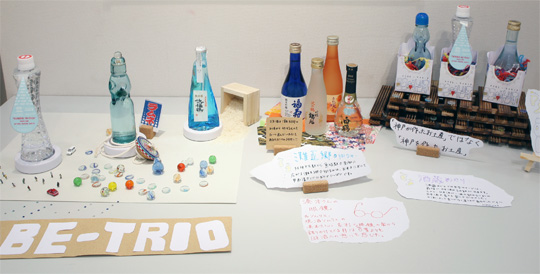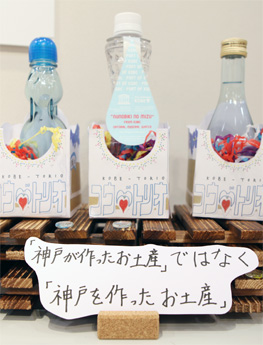

“Kobe is the Mecca of beverages.”
We propose a collection of three types of beverages popular in Japan—water, sake, and Ramune (a type of soda pop)—in traditional forms created by craftsmen, as a package titled the “Kobe Trio.” By so doing, we aim to emphasize natural beauty, traditional culture, technologies, internationalization, and safety, which have always been the advantages of Kobe, as well as the passion of those involved in creating these products.
Nunobiki-no-mizu (Water of Nunobiki)
The calcium content of Nunobiki-no-mizu is among the highest in Japan, and this water is characterized by its perfect balance of mineral constituents. In the old days, seamen on international travels stocked their vessels with this prized drinking water while stopping at Kobe Port, and Nunobiki-no-mizu was hailed as the “best water in the world” because it maintained its good quality and taste even after crossing the equator.
Kobe No.18 Ramune
The Kobe foreign settlement is known as the birthplace of Raumne (a type of soda pop). Sim Shokai (Sim and Company) run by Alexander Cameron Sim began to manufacture and sell this drink around 1884. In those days, Ramune was reported to have the ability to protect against cholera, and it became a big hit. Ramune was called “No.18” because the location of Sim and Company was designated “block number 18.”
Nada-no-sake
The Nada region is blessed with a favorable natural environment. Cold winds known as Rokkko oroshi blow down from the Rokko Mountains through the city, creating the right climate for sake production, and the natural water of Mount Rokko ensures the supply of high quality water. In addition, rice of excellent quality produced on the Banshu plain is available in large quantities. The combination of the advantageous natural environment and unique outstanding technologies enabled the creation of Nada-no-sake, which is known for its distinctive characteristics.
While hoping that the Kobe Trio will be used not only for souvenirs but also for various events in Kobe, we aim to develop the merchandise into something like a mascot for Kobe that will become a popular topic of conversation, prompting people to drink it when they visit Kobe.
Kobe Shukugawa Gakuin University: Kinji Onoda
The participants in the project are students in the Department of Tourism and Culture. The students have experience in art events and tourism promotion activities, and they seemed to work assertively and with confidence. However, as they actually proceeded with the development of souvenirs, they found themselves lacking in “ability to create something from scratch” and seemed to recognize the importance of the ability to cast ideas into shape.
In the field of community-driven tourism, which is popular these days, souvenirs are expected to have positive economic effects on the community, along with other forms of tourism-related spending, such as accommodation. In reality, however, well-designed souvenirs that have stories associated with a given community and make use of local materials are scarce. As one solution to this problem, our students learned about the development process through this project, which provided them with a meaningful experience. However, as a teacher, to my regret, I was not successful in inspiring students to take advantage of youthful abandon in their works.
It has been proven that this project, hosted by the cities of Nagoya and Kobe, served as a powerful measure to promote regional tourism and motivated us to think about characteristics of the two regions. It was also interesting that the two cities delivered different evaluation results.